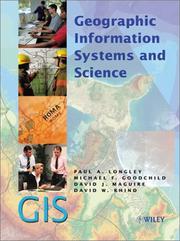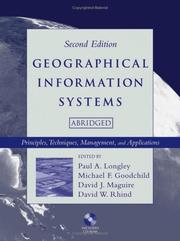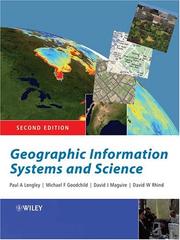| Listing 1 - 10 of 11 | << page >> |
Sort by
|
Book
ISBN: 0470211946 0582301718 Year: 1989 Publisher: Harlow : Longman,
Abstract | Keywords | Export | Availability | Bookmark
 Loading...
Loading...Choose an application
- Reference Manager
- EndNote
- RefWorks (Direct export to RefWorks)
Geography --- Geografie --- Data processing. --- Geografische Informatie Systemen --- Toepassingen. --- Aardrijkskunde. Geografie --- Information systems applications (GIS etc.) --- 681.3*H4 Information systems applications (GIS etc.) --- 91 --- 681.3 --- 681.3*H4 --- Computerwetenschap --- 681.3* / / / / / / / / / / / / / / / / / / / / / / / / / / / / --- Data processing --- GEOGRAPHIE --- QUANTITATIVE
Book
ISBN: 0306443422 146136504X 1461534046 Year: 1992 Volume: vol 316 Publisher: New York, NY : Plenum Press,
Abstract | Keywords | Export | Availability | Bookmark
 Loading...
Loading...Choose an application
- Reference Manager
- EndNote
- RefWorks (Direct export to RefWorks)
Oxygen --- Physiological transport --- Congresses --- Oxygen in the body --- Measurement --- Oxygen - Physiological transport - Congresses. --- Oxygen in the body - Measurement - Congresses. --- BIOLOGICAL TRANSPORT --- OXYGEN --- OXYGEN CONSUMPTION --- BLOOD

ISBN: 0471892750 0471495212 9780471892755 9780471495215 Year: 2001 Publisher: Chichester : J. Wiley,
Abstract | Keywords | Export | Availability | Bookmark
 Loading...
Loading...Choose an application
- Reference Manager
- EndNote
- RefWorks (Direct export to RefWorks)
Geographic Information Systems and Science is a landmark in the evolution of GIS. It is a book that captures and redefines the richness and diversity of GIS, in an accessible form. It presents a clearly-defined path to a world of learning about GIS, using the Internet and closely-couples reference sources. It is richly produced and illustrated unlike any other in the field, with over 300 full color illustrations. Geographic Information Systems and Science is unique in several ways. It presents comprehensive treatments of: *Geographic Information Science - the scientific context to GIS, technical content and geographic implications *The real value of GIS - illustrated using real world applications. Treatments emphasize operational, tactical and strategic issues *The impact of Internet GIS on interdisciplinary science and society *The pivotal role of GIS as a business driver in the information age - including the role of GIS as a business asset and the operational dynamics of its use in practice The book is the first to provide a gateway to Internet-based classroom and distance learning. A series of modules of the ESRI Virtual Campus have been specially written around the material in this book, and detailed learning guides identify other on-line sources. Additional free supplementary reference material is available through a Web site dedicated to the book Contents The book begins by developing the themes of GI Systems and GI Science, and illustrates the practical value of GIS through real case studies. The major parts then consider: *GIS Principles *GIS Techniques *GIS Practice A concluding section anticipates the future of GIS and prospects for the people who use it. This book is suitable for 2nd/3rd year undergraduates taking courses in GIS within departments of Geography, Environmental Science, Forestry, Business Studies and Economics, Computer Science, Information Technology, Planning, and Archaeology. It is also suitable as a foundation course taught in M.
Système d'information géographique --- Geographical information systems --- Geography --- Collecte de données --- data collection --- Analyse de données --- Data analysis --- Banque de données --- Databases --- Geographic information systems. --- Problem solving. --- Geografie --- Geografische Informatie Systemen --- Algemeen. --- 681.3*H4 --- Information systems applications (GIS etc.) --- 681.3*H4 Information systems applications (GIS etc.) --- Geographic information systems --- Problem solving --- Methodology --- Psychology --- Decision making --- Executive functions (Neuropsychology) --- GIS (Information systems) --- Information storage and retrieval systems --- Systeme d'information geographique (s.i.g.)

ISBN: 0471735450 9780471735458 Year: 2005 Publisher: Hoboken (N.J.) : Wiley,
Abstract | Keywords | Export | Availability | Bookmark
 Loading...
Loading...Choose an application
- Reference Manager
- EndNote
- RefWorks (Direct export to RefWorks)
Praise for the Second Edition: -International Journal of Geographical Information Science -Australian Geographical Studies -Annals of the Association of American Geographers -Transactions in GIS Since the publication of the First Edition of Geographical Information Systems in 1991, the "Big Book" of GIS has become the definitive work on the science, application, and practice of GIS. This new Abridged Second Edition of Geographical Information Systems brings this definitive reference to a whole new audience, with a streamlined format, a new chapter covering recent developments in GIS, and the full text of the Second Edition of Geographical Information Systems, seventy-two chapters in all, on the accompanying CD-ROM in searchable PDF format. Unmatched in scope by any other reference on the subject, Geographical Information Systems, Second Edition provides crucial background on basic GIS concepts and addresses the radical shifts and changes that have taken place in GIS technology and its uses. Included in this Abridged Edition are twenty-four chapters covering topics as diverse as issues of space and time in GIS, problems with data quality, uncertainty and error detection, spatial analysis, developments in GIS architecture and spatial databases, GIS data collection, data transformation and linkage, implementing GIS and using it as a management tool, and the societal and legal implications of GIS and spatial information. This affordable Abridged Edition provides a convenient reader for students taking any of a wide range of GIS courses, and serves as a concise reference for professionals working with GIS.
Geografie --- Geographic information systems. --- Geografische Informatie Systemen --- Algemeen.
Digital
ISBN: 9780387717647 Year: 2008 Publisher: Boston, MA Springer Science+Business Media, LLC
Abstract | Keywords | Export | Availability | Bookmark
 Loading...
Loading...Choose an application
- Reference Manager
- EndNote
- RefWorks (Direct export to RefWorks)
Immunology. Immunopathology --- Physiology of the respiratory system --- Human physiology --- immunologie --- pneumologie --- fysiologie
Book
Year: 2002 Publisher: Chichester Wiley
Abstract | Keywords | Export | Availability | Bookmark
 Loading...
Loading...Choose an application
- Reference Manager
- EndNote
- RefWorks (Direct export to RefWorks)

ISBN: 1281043311 9786611043315 0387717641 0387717633 Year: 2007 Publisher: New York : Springer,
Abstract | Keywords | Export | Availability | Bookmark
 Loading...
Loading...Choose an application
- Reference Manager
- EndNote
- RefWorks (Direct export to RefWorks)
At the beginning of a Southern Hemisphere Autumn, the ISOTT tribe assembled for its annual corroboree on the banks of the Brisbane River in Australia for five days of exciting science. Some of the tribe had travelled from as far as Sweden and other parts of Europe; many had spirited themselves across the Pacific Ocean from the Americas. Yet another small contingent had paddled down from Japan. All came with message sticks from their camp-sites. The conference opened with an outdoor barbecue at the Southbank precinct, with the stars of the Southern Cross painting the river on one side and the artificial beach on the other; a perfect venue to meet old friends and to welcome new ones as a cool breeze wafted over our fires. For the next five days there was the usual focus on oxygen; measurement techniques, its role in cancer and other diseases that beset us mortals and the biochemistry and physiology of this small vital molecule. It still astounds many that we have not yet learnt everything there is to know about this valuable friend, albeit a dangerous foe. Time was found for us to visit Australia Zoo and stand in awe before exhibits of Australia’s wild-life; great vicious creatures unchanged from the age of the dinosaurs, poisonous snakes and spiders, and gentle marsupials that posed for our digital cameras.
Oxygen --- Physiological transport --- Life sciences. --- Human physiology. --- Immunology. --- Respiratory organs --- Biochemistry. --- Life Sciences. --- Biochemistry, general. --- Human Physiology. --- Pneumology/Respiratory System. --- Diseases. --- Biological chemistry --- Chemical composition of organisms --- Organisms --- Physiological chemistry --- Biology --- Chemistry --- Medical sciences --- Respiratory diseases --- Immunobiology --- Life sciences --- Serology --- Human biology --- Physiology --- Human body --- Biosciences --- Sciences, Life --- Science --- Composition --- Chalcogens --- Nonmetals --- Photosynthetic oxygen evolution --- Pneumology. --- Respiratory organs—Diseases.

ISBN: 9780470870013 047087001X 9780470870006 0470870001 Year: 2005 Publisher: Chichester : John Wiley & Sons,
Abstract | Keywords | Export | Availability | Bookmark
 Loading...
Loading...Choose an application
- Reference Manager
- EndNote
- RefWorks (Direct export to RefWorks)
Geographic information systems --- Systèmes d'information géographique --- GIS --- 528.9 --- 681.3*H4 --- 528.9 Cartography. Mapping (textual documents) --- Cartography. Mapping (textual documents) --- Geographical information systems --- GIS (Information systems) --- Information storage and retrieval systems --- Computer science--Information systems applications (GIS etc.) --- Geography --- Artificial intelligence. Robotics. Simulation. Graphics --- Geodesy. Cartography --- Geographic information systems. --- Environmental Sciences and Forestry. Remote Sensing and Geographical Information Systems --- Geographical Information Systems.
Book
ISBN: 0470721448 0470721456 9780470721445 9780470721452 Year: 2010 Publisher: Hoboken, N.J. : Wiley ;,
Abstract | Keywords | Export | Availability | Bookmark
 Loading...
Loading...Choose an application
- Reference Manager
- EndNote
- RefWorks (Direct export to RefWorks)
Effective use of today's powerful GIS technology requires an understanding of the science of problemsolving that underpins it. -- Since the first edition was published a decade ago, this book has led the way, with its focus on the scientific principles that underpin GIS usage. It has also Provided through, up-to-date coverage of GIS Procedures, techniques and Public Policy applications. This unique combination of science, technology and practical problem solving has made this book a bestseller across a broad spectrum of disciplines. -- This fully updated 3rd edition continues to deliver on these strengths. --Book Jacket.
Geographic information systems. --- Environmental Sciences and Forestry. Remote Sensing and Geographical Information Systems --- Geographical Information Systems. --- 681.3*H4 --- Information systems applications (GIS etc.) --- GIS --- cartografie --- 681.3*H4 Information systems applications (GIS etc.) --- Geographic information systems --- 528.9 --- Geographical information systems --- GIS (Information systems) --- Information storage and retrieval systems --- 528.9 Cartography. Mapping (textual documents) --- Cartography. Mapping (textual documents) --- Geography --- Artificial intelligence. Robotics. Simulation. Graphics --- Geodesy. Cartography --- Problem solving.
Book
ISBN: 9780387717647 Year: 2008 Publisher: Boston, MA Springer Science+Business Media, LLC
Abstract | Keywords | Export | Availability | Bookmark
 Loading...
Loading...Choose an application
- Reference Manager
- EndNote
- RefWorks (Direct export to RefWorks)
At the beginning of a Southern Hemisphere Autumn, the ISOTT tribe assembled for its annual corroboree on the banks of the Brisbane River in Australia for five days of exciting science. Some of the tribe had travelled from as far as Sweden and other parts of Europe; many had spirited themselves across the Pacific Ocean from the Americas. Yet another small contingent had paddled down from Japan. All came with message sticks from their camp-sites. The conference opened with an outdoor barbecue at the Southbank precinct, with the stars of the Southern Cross painting the river on one side and the artificial beach on the other; a perfect venue to meet old friends and to welcome new ones as a cool breeze wafted over our fires. For the next five days there was the usual focus on oxygen; measurement techniques, its role in cancer and other diseases that beset us mortals and the biochemistry and physiology of this small vital molecule. It still astounds many that we have not yet learnt everything there is to know about this valuable friend, albeit a dangerous foe. Time was found for us to visit Australia Zoo and stand in awe before exhibits of Australia's wild-life; great vicious creatures unchanged from the age of the dinosaurs, poisonous snakes and spiders, and gentle marsupials that posed for our digital cameras.
Immunology. Immunopathology --- Physiology of the respiratory system --- Human physiology --- immunologie --- pneumologie --- fysiologie
| Listing 1 - 10 of 11 | << page >> |
Sort by
|

 Search
Search Feedback
Feedback About UniCat
About UniCat  Help
Help News
News